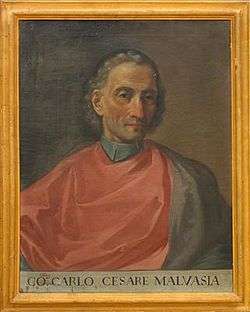Carlo Cesare Malvasia

Carlo Cesare Malvasia (1616–1693) was an Italian scholar and art historian from Bologna, best known for his biographies of Baroque artists titled Felsina pittrice, published in 1678.[1]
Life and career
Malvasia is the Bolognese equivalent of Giorgio Vasari, and saw his native city surpassing Florence in the artistic supremacy of his time. Born to an aristocratic family, he is also known as Count Carlo Malvasia. He received cursory training in painting under Giacinto Campana and Giacomo Cavedone. He also was an amateur poet and participated in local literary circles. He traveled to Rome in 1639 where he met Cardinal Bernardino Spada and the sculptor Alessandro Algardi. Records indicate he spent some time as a volunteer cavalier during the First War of Castro at the urging of his cousin Cornelio Malvasia; leader of the Papal Army cavalry.[2]
Thereafter he graduated as a lawyer, and lectured on the subject at the university in Bologna. He obtained a theology degree in 1653, and was appointed a canon in Bologna Cathedral in 1662.
Malvasia was also a collector and acted as an agent for Louis XIV in acquisition of Bolognese artworks for the royal collections.
Works
.jpg)
Felsina pittrice, vite de’ pittori bolognesi is a primary source of information about the Bolognese school of painters of the 14th - 17th centuries, and for some of the artists included, the only source of information. The text is divided into four historical sections, with the first on the trecento painters, the second focusing on Francesco Francia, the third devoted to the Carracci, and the fourth (and most valued today) providing detailed, firsthand accounts of the lives and careers of the artists who rose to pre-eminence during the 17th century in the wake of the Carracci reform, including Guido Reni, Guercino, Domenichino, and Lanfranco.
Felsina pittrice has been criticized for its inaccuracies and unfavorably compared to Le vite de' pittori, scultori et architetti moderni (1672) by Malvasia's contemporary, Giovanni Pietro Bellori, on the grounds of that Malvasia's text is a mere compilation of facts embellished with poetic language, lacking in critical assessments and governed by no theoretical framework other than a provincial attachment to his native city. Recent scholarship has taken Malvasia more seriously as an art historian and the Center for Advanced Study in the Visual Arts is preparing the first scholarly, critical edition since 1841, accompanied by the first English translation, of the complete text of the Felsina pittrice (two of the planned sixteen volumes of which have been published).[3]
Malvasia also published Le pitture di Bologna (1686), a companion gallery guide of works by the artists discussed in the Felsina pittrice, and Marmorea felsine, a guide to Bolognese antiquities (1690).
Notes
- ↑ Felsina is an archaic Latin name for Bologna.
- ↑ Malvasia & Summerscale 2000, p. 15.
- ↑ Elizabeth Cropper et al., Carlo Cesare Malvasia’s Felsina pittrice: Lives of the Bolognese Painters, Volume 1, Early Bolognese Painting and Volume 13: Lives of Domenichino and Francesco Gessi (Washington, DC: Center for the Advanced Study in the Visual Arts, 2013).
Bibliography
- Malvasia, Count Carlo Cesare (1769). Luigi Crespi with contributions by Marco Pagliarini, ed. Felsina pittrice: vite de pittori bolognesi (tomo terzo : all maesta de Carlo Emanuele III. re di Sardegna &c. &c.). Stamperia di Marco Pagliarini, ; Digitized by Googlebooks from Oxford University copy on February 7, 2007. p. 688 pages.
- Malvasia, Cesare; Summerscale, Anne (2000). Malvasia's Life of the Carracci: Commentary and Translation. University Park, PA: The Pennsylvania State University Press. p. 15. ISBN 9780271044378.
- Massimi, Maria Elena (2007). "Malvasia, Carlo Cesare". Dizionario Biografico degli Italiani (in Italian) 68. Treccani.
- Pace, Claire (1982). "Review: Carlo Cesare Malvasia: The Life of Guido Reni by Catherine Enggass, Robert Enggass", The Burlington Magazine, vol. 124, no. 950 (May), pp. 306–308.
External links
| Wikimedia Commons has media related to Carlo Cesare Malvasia. |
- Dictionary of art historians entry
- Felsina pittrice, 1678, catalog record at HathiTrust of digitized versions of copies at the Getty Research Institute
- Digitized edition of Le pitture di Bologna : che nella pretesa, e rimostrata sin'hora da altri maggiore antichita, & impareggiabile eccellenza nella pittura, con manifesta evidenza da fatto, rendono il passeggiere disingannato ed instrutto dell'Ascoso, accademico gelato. Monti, Bologna 1706
|